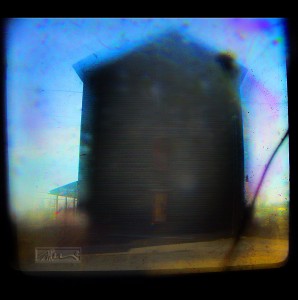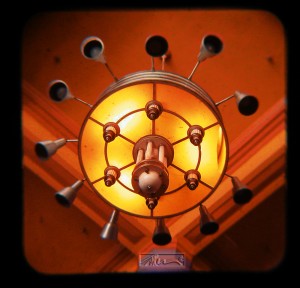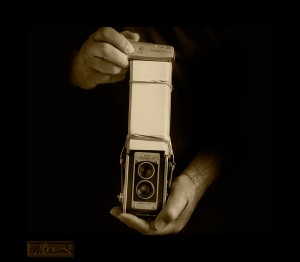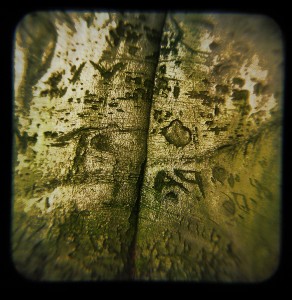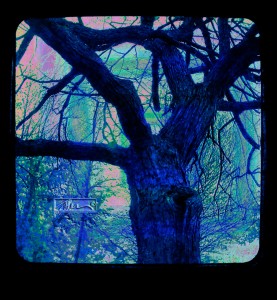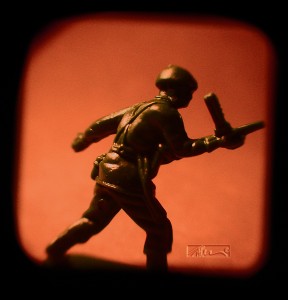TTV is a playful and fun way to make images.
The thing is, with TTV, you need to use two cameras to get the image.
At first you might think that the technique seems a bit strange. It can seem especially odd when considering all of those camera plug-ins and apps that can create so many different kinds of artsy photographic looks. But sometimes, at least for many of us, it is simply a lot more fun to take a stab at something unique. TTV is a different way to make a photograph. And in some respects, it is also a better way.
TTV stands for Through The Viewfinder. Who would think that you could shoot an image off another cameras viewer. While it may seem weird, it is actually a lot of fun.
The technique uses two different cameras to form produce the final results. Basically, there is a taking camera; used to shoot the image, and a second camera we’ll call the bottom camera, which forms the image. For the sake of simplicity, lets call the first camera the top camera and the second one will be the bottom. Although it is possible to use the cameras in different configurations, the method described here is the way most of us do it.
TTV produces many different looks. Typically, the results look like they were taken with a toy camera such as a Diana or a Holga. Depending on the cameras used, they can also have a highly refined appearance. I see it as an alternative method of producing photographs.
Rather than go into all the details, I will simply mention some basics and show a few images that will hopefully get you interested in producing your own TTV imagery.
The most basic principle is to take a picture of another cameras viewfinder. That sounds easy enough, but there are cameras, which are more conducive to this way of making pictures than others. Most TTV image-makers use the simple versions of the metal or Bakelite TLR (better known as Twin Lens Reflex) cameras from the 1960’s. I love the different looks that come from the different camera manufacturers. Most of mine are from Argus, Kodak and Voigtlander. There are some TTV users such as myself, who have found the viewfinders of other cameras to be equally interesting.
These cameras usually utilize a squarish magnifier in the upper chamber of the TLR to form an image of what the lens is seeing. This magnifier image or in some cases, a piece of ground glass, is what we TTV photographers take pictures of.
In order to do so, it is best to create a chimney, which sits on the top of the bottom camera that serves to block out extraneous light and functions as a place to rest the top camera. This chimney can be produced from any kind of material that does the job. I’ve made them from beer glass insulators, tin cans, cardboard tubes and a black shirt sleeve and many other similar objects. I hold mine together with tape, rubber bands and at times small bungee cords. Whatever you use ends up being what we refer to as “The Device” or “The Contraption”. The people that do this kind of work tend to build the devices as simple or as elaborate as they see fit. They also like to show off their cleverness with whatever they might kludge together and upload their results to on line image sharing sites.
Whatever one might build is usually kept pretty simple and made from next-to-nothing materials and at little to no expense. As mentioned above, most of mine have been made from the simplest things I can conjure. However, I have seen some pretty elaborate contraptions. The great thing is that TTV offers a “to each his/her own” approach, which means that you can be as simple or as inventive as you see fit. All it has to do is function well enough to allow the image to be captured. It is the image that after all is the most important.
TTV allows people to create some pretty interesting images from cameras that would otherwise be tossed in the trash. In some ways this is an environmentally driven way of making photographs.
To use a TTV device, find a subject that you frame with the viewfinder of the bottom camera, point the top camera down the chimney towards the viewfinder of the bottom camera and shoot the image that is formed.
Digital cameras make this very simple. What you see on the back of the camera is what you should end up with as an image.
Easy peasy!
One of the distinctive features of this technique is the framing that happens with the type of camera used. These frames can vary depending on the shape of the viewfinder. Some have round corners and others might have a more squared shape. Each manufacture had a slightly different configuration. There are also optical effects that can happen with the glass, which can happen when the camera is tilted slightly away from the vertical axis, which at times can make the images more interesting.
While some might consider this to be a very primitive way of making photographs, there are many who do it for that reason. I personally find that the results can resemble some of the imagery that was produced in the early days of image making. I find the results can also be toy like. They are different from the run of the mill. They probably fit somewhere into a snapshot kind of aesthetic. But snapshots can fit in the category of art. It is very possible that the technique can be used in ways that nobody has used it before.
If nothing else, it will allow you to begin seeing the world through a very different way of framing. What I did not mention above is that the image formed is flipped from what one might expect left to right. But that is what has always happened in a TLR unless the image is corrected with some sort of prism. What that means, is that you will find the framing to be a bit strange when you first use the device. But it doesn’t take long to master the art of moving the camera in the proper direction. In fact, it is part of what makes this a fun to do method.
TTV is something I do when I need a change of pace. It allows me to play with another way of picture making. For me, it is an alternative from the stuff I usually create and a means to see the world from a different perspective. It forces me to see things differently. It offers a way to see the simple things and those things that we seem to forget. It allows me to see a world that is somewhat backwards, slightly disoriented and a bit strange, which in many ways mimics the way the world really is.
I hope to offer more about TTV in the near future. In the meantime, I discuss TTV in my book.
I cover many photographic other topics in my book, including, alternative lenses, pinhole, HDR and digital painting. – Great Photography Gift Idea for the Holiday.
Please have a look at some of my other posts here.
NOTICE of Copyright: THIS POSTING AS WELL AS ALL PHOTOGRAPHS, GALLERY IMAGES, AND ILLUSTRATIONS ARE COPYRIGHT © JOHN NEEL AND ARE NOT TO BE USED FOR ANY PURPOSE WITHOUT WRITTEN CONSENT FROM THE WRITER, THE PHOTOGRAPHER AND/OR lensgarden.com. THE IDEAS EXPRESSED ARE THE PROPERTY OF THE PHOTOGRAPHER AND THE AUTHOR.


